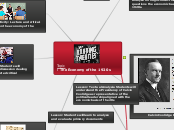Floating topic
Lesson: Textual Analysis-Students will understand the Presidency of Calvin Coolidge as representative of the political leadership aligned with the economic basis of the 20s
Students will understand the relationship between government and the economy in the 1920s
UNIT PLAN MAP
Lesson: Students will learn to analyze and evaluate primary documents
Students will understand the conduct of historical characters and the ramifications of their policies on the issue of economic intervention during the end of the 20s.
Simulation
Employing the policies, biography, and writings of historical figures students are to attend a teacher led lecture with guided notes
Assessment: Guided Notes (use rubric)
Students will engage in open discussion (in role). Students may try and sway those of differing opinions. Each student may pose a question and/or ask a point of clarification to another historical figure. Students will take notes of the discussion/debate in preparation for the summative writing assignment.
Assessment: Students will write a summative 500-1,000 word paper in which they cite statements and arguments made by others at the discussion/debate to address the following question: What is the relationship between interventionist or non-interventionist policies and prosperity? What economic policies enhance prosperity? Students will be encouraged to cite specific policies/or primary sources to bolster their position
Students will enact the roles of several historical characters relevant to the economy of the late 1920s. Each student will enact one or more roles. The roles will consist of the major players in governmental policy from the Presidency of Teddy Roosevelt to the Presidency of FDR and the beginning of The Great Depression. The figures will offer recommendations for governmental economic policies that will be discussed in light of the crash of 1929. Students will be expected to clarify their positions and to offer evidence to support their claims.
Assessment: Student participation in the simulation (use rubric)
Assessment: Writing Assignment: In a short essay (300-500 words), the student will explain the economic policies of one of the historical characters.
Thus, students will prepare for the discussion/debate with a written argument, which expresses an historical figure’s economic position. Students will explain why they are interventionist or non-interventionist. They will incorporate primary sources provided by the instructor. Students will conclude with a summary of their position and why it will better the future. (use rubric)
Topic: The Economy of the 1920s
Comparison of three primary documents , one each from Harding, Coolidge, and Hoover dealing with their contrasting views of the relationship between government and the economy
Instructor will demonstrate the proper use of the "Written Document Analysis Form"
Instructor will introduce the material by inquiring of students present knowledge regarding Harding, Coolidge, and Hoover
Students will analyze 3 primary documents using the "Written Document Analysis Form"
Assessment: Student will participate in a whip around with instructor initiated questions
Assessment: Students will produce a brief essay outlining their position employing specific quotes from the 3 documents
Assessment: Students will participate in an open discussion with other students of their views regarding the 3 primary documents
Student Activities: Students will engage in a group discussion dealing with instructor directed critical questions
Teacher Activity: Lecture and critical-questions on the economy of the 1920s
Discussion
Students will be able to rebut each other by using critical reasoning based on factual data.
Assessment: Students will produce a cogent 300-500 word essay discussing their evaluation of the role of government and the economy. Students will employ critical reasoning relying on factual information and arguments made by other students in the discussion. (use rubric)
Assessment: Whip around
Assessment: Student participation in the discussion (use rubric)
Students will engage their classmates with informed reasons for their view.
Students will engage with at least three primary questions: 1) What is the role of the government and the economy in the period preceding the 20s? How is the relationship of the government and the economy different in the 20s? What is your assessment and/or evaluation of the two periods and their relationship of the government and the economy?
Assessment t: Guided Notes (use rubric)
Calvin Coolidge Presidency
Employing a history textbook students will read a chapter on Calvin Coolidge identifying and describing his political policies and their relationship to the economy
Assessment: Students will produce a short essay relating their new information with existing knowledge
Students complete a whip around of learned concepts
Assessment: Students will produce a timeline of the policies of Calvin Coolidge
Students identify phases, quotes that identify Coolidge's econmic views
Teacher forms questions for whip around that involve several levels of Bloom's taxonomy
Instructional Objective: Students will analyze through critical-thinking questions the economic basis of the 1920s.
Assessment: Students will address and discuss in a group format critical-thinking questions related to the economy of the 1920s









